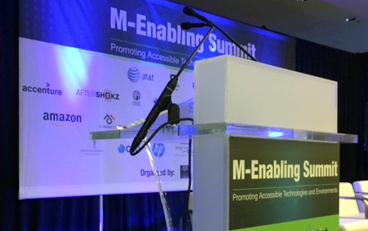
This year’s M-Enabling Summit, an initiative that showcases the latest in accessible technologies and environments for senior citizens and individuals with disabilities, was illustrative of the progress made in web accessibility, but also exposed areas where significant challenges remain. The summit provided a gathering place for executives and accessibility professionals from Government, Industry and Advocacy Organizations around the world to review and discuss the most recent accessible information technology innovations.
The theme of “Accessibility: Transforming Users’ Experience” was prevalent throughout the conference. On many occasions, the experienced panelists reinforced the notion that accessibility does not mean just meeting the targets set out within the WCAG guidelines. Rather, this is the bare-minimum requirement, and that accessibility also incorporates usability. For example, a user’s experience with a screen reader or his or her interaction with a website needs to be taken into account and is critical in ensuring the site is usable as intended. The key to making a good accessible website is providing a great user experience The Keynote address by Neil Romano, Chairman of the National Council on Disability, provided inspiration, stating that accessibility is a civil rights struggle, and people must not be left behind. The idea of user inclusivity rather than just a UI or UX exercise as part of the development process is essential.
There was also discussion of the legal challenges faced by website owners, as organizations and companies large and small, have been increasingly hit with lawsuits over having inaccessible websites. There have been occasions where lawsuits are filed without substantial basis, with individuals, businesses and educational institutions all having to pay damages. In some cases, the site owners did not have any idea about the legal requirements of their sites. Legislation has been proposed to give website owners, who receive a lawsuit over an inaccessible website, a grace period within which to remediate any accessibility issues. This ‘safe harbor’ approach seems to make sense and will still move the path forward in making websites more accessible in the future.
I attended a useful panel discussion on accessibility testing. The importance of verifying that third-party tools are accessible was raised. This verification should be completed at the procurement stage with an audit of the tool’s accessibility. Also, with procurement, the VPAT (Voluntary Product Accessibility Template) should be read closely, and questions asked about the claims they contain. One of the most important takeaways from the conference was the need for building an accessible website should start at schools during the time when children are first introduced to coding. Learning the ‘right-way’ to create a web page, using semantic html, for instance, is the first step to achieving accessible sites.
The numerous seminars at the M-Enabling conference had many positive lessons. There is much work to be done, and I look forward to seeing how far web accessibility grows in a year’s time.
[
